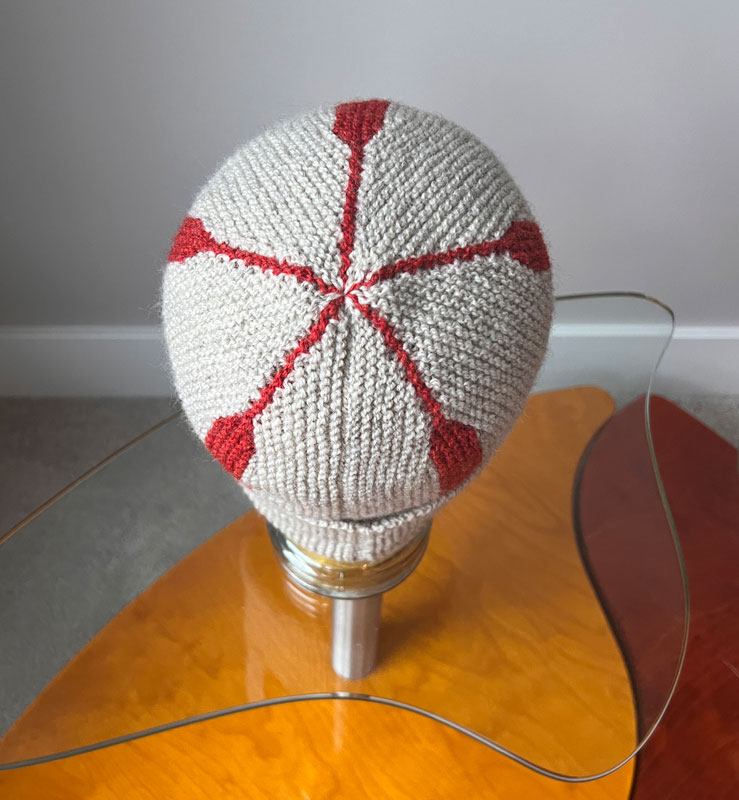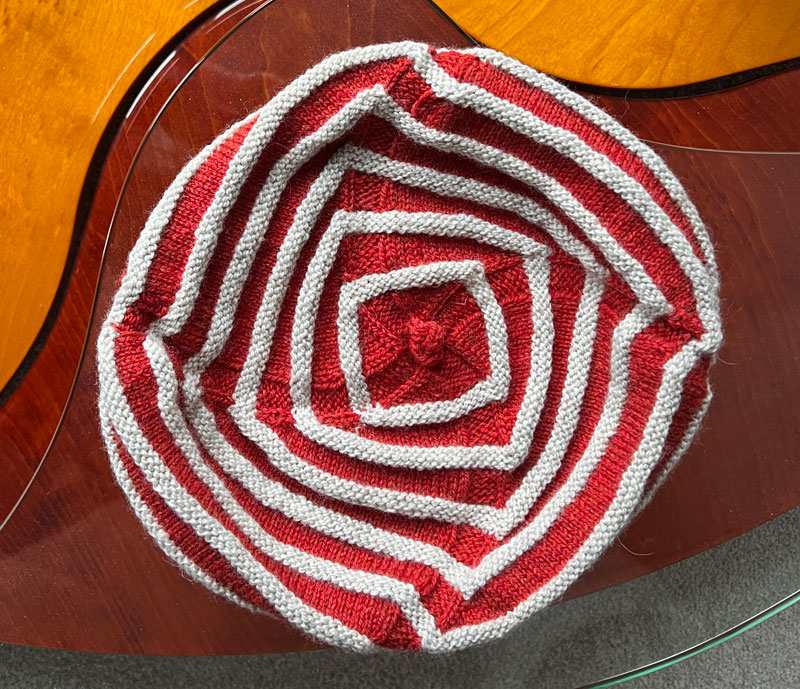
Each of these accessories are knit in Purl Soho Good Wool. The company lists its Good Wool as “sportweight to light worsted/DK weight” at “5.5-6.25 stitches per inch” on US needles sizes 4-6. My call is that it’s a sportweight. Anyway, recently I’ve been having fun knitting different patterns in the same yarn to see, well…just to see I guess.
First up is Purl Soho’s freebie hat and mitten pattern: All Roads.

Warm, for sure with that doubled brim. And just up my alley with miles of garter stitch. Thanks to well-placed short rows the “roads” narrow. And they intersect thanks to well-thought out crown decreases.

I couldn’t be more pleased with my new warm hat. Here’s the entire set.

Handsome.
Maybe you noticed the thumbs don’t seem to match exactly? These mittens are an odd (but clever) construction. On one mitt you create the thumb at the end of the knitting and on the other you create it at the start. My theory is that there’s something in that construction that rounds up one thumb a tad more than the other. Once your hands are in the mittens, the slight thumb disparity completely disappears.

All Roads mittens are left and right specific. Here’s a look at the palm sides and, again, those thumbs.

Same yarn. In a very different hat pattern. This one’s Traci Bunker’s Reversible Rotating Ridge Hat. Before the big reveal on how this hat looks on a head, here’s why a knitter wants to knit this hat.

Is that cool or what? How does it work out this way? Magic, I think. My only hint is that it’s knit from the top down. That’s not much of a hint.
Here’s Glasshead modeling Bunker’s creation.

I’ve knit this hat twice before and each time finishing the hat once the rotating stops hasn’t worked out well. The bind off is either way too loose or way too tight. This time I tried different endings. What worked best for me was following the pattern with one modification. Instead of leaving all 208 live stitches entering into the knit-on double I-cord bind off, I decreased the stitch count down to about 155. Then I worked the first I-cord band with a needle size 2 sizes smaller than the body of the hat (a US 2 instead of a US 4). Instead of decreasing every 8th stitch in the I-cord band by slipping 3 stitches instead of 2, I simply worked a knitted-on 5-stitch I-cord, without any decreases. I made that same modification for the second I-cord band. These modifications drew the stitches together enough to tighten up the bands. Phew! In my first two tries, while I played with a knit 2 purl 2 ribbing, my finished hat ended up looking like a snood. Now it’s more appropriately beanie-like.

I also decided I didn’t want a pointy itsy bitsy I-cord sticking out at the top. So I lengthened the I-cord at the outset and then just knotted it up.
I believe the real problem with this knit is that my gauge was off. Off by a lot is the only explanation. I will protest that I checked my gauge (I did, twice). But I must simply have read my stitches wrong. Once I’d checked my gauge at the recommended needle size, a US 2, I moved to a US 4 and thought I had gauge. Anyway, the ending I-cord modifications fixed the hat. Pretty much fixed it. Even after blocking you can see that there’s a puckering between the main body of the hat and the I-cords. Not the end of the world. What was almost a silly snood transformed to an entirely useful cute hat with a stunning somewhat slouchy beanie body.
I started out with the required number of skeins for my All Roads set in size large–2 skeins of Winter Grass and one of Roma Tomato. But I only needed about an inch of the second skein of Winter Grass and not many yards of that tomato. Some elf must have been sneaking in each night to spin more of this yarn. It just would not cooperate with my efforts to leave no major oddment unknitted.
For something completely different, I knit Houndstooth Headband by Karolina Adamczyk. Actually not completely different because it’s still a Purl Soho Good Wool project.

Such a cute pattern. A sweet 1940’s look.
Through no fault of the designer, so far this headband is an unfortunate epic failure. I knit it, ahem, beautifully. And the pattern is clearly written and error-free. But at the end you need to fold the work a certain way and sew through 8 layers of knitted fabric. My sewing skills, as in my lack of them, totally trumped my knitting skills. I goofed and initially missed a few inside layers. When I tried to recover from my mistake, it just got more messed up. I ended up catching all the layers but the sewing is way too bulky. I tried to unravel the seam but that only made matters worse since I couldn’t always distinguish between my sewing yarn and my knitting yarn. Because of my mistakes the lumpy seam will be uncomfortable for everyone except Felthead. Drat. Drat. (Felthead does look cute in it though.)

Don’t be deterred from knitting this by my lack of sewing success. It was a failure of execution and not a design or pattern failure! My knitting buddy Cristie knit Houndstooth Headband and it came out perfectly.
I’ve a daring recovery plan. I plan to sew (or have someone with a sewing machine help me sew) a strong new seam through all the layers below where my messy seam is. Then I will cut the bulky sewn mess out. Sort of a steek. As it stands now, only Felthead can enjoy this headband. If all goes well maybe my 8-year-old granddaughter will benefit from my goof.




